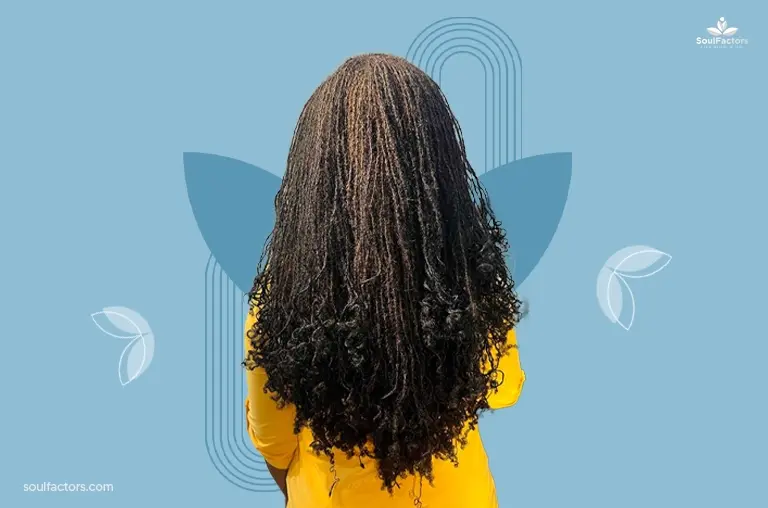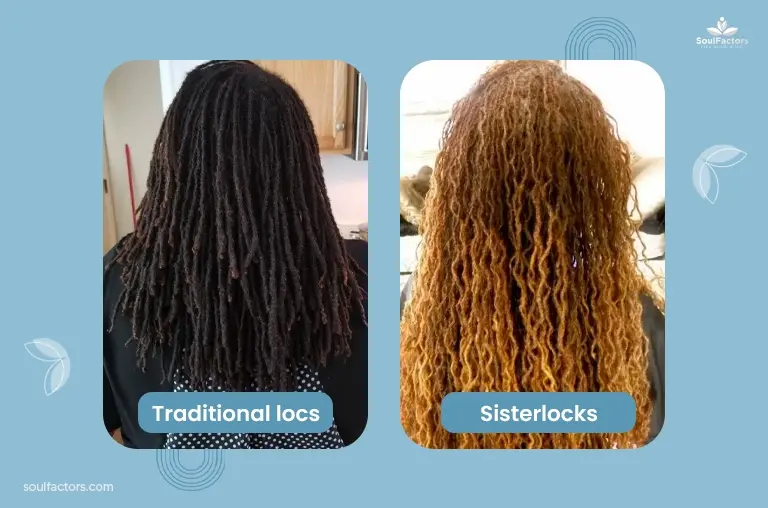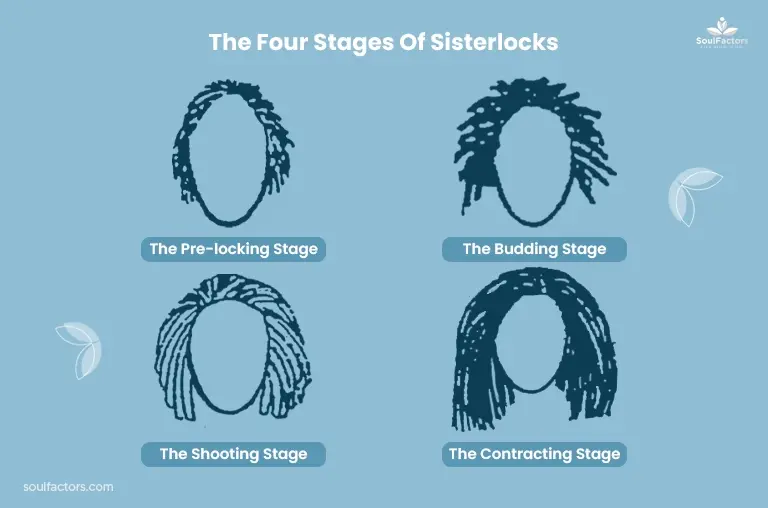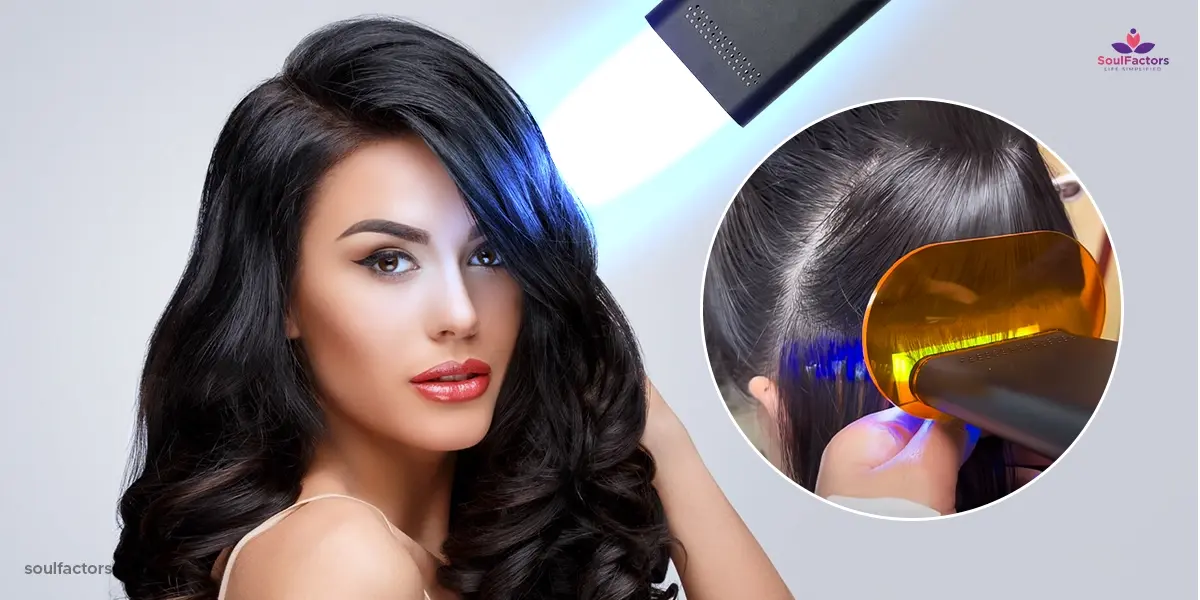Sisterlocks From Cost To Care All You Need To know About This Trendy Hairstyle
Sisterlocks are not just a hairstyle, but a commitment to loving and caring for your natural tresses.
On May 4, 2023 – 11 minutes read

Spending hours in front of the mirror, taming and untangling your coily hair, can be frustrating. It feels even worse when you witness several strands of hair tangling on your comb. If you deal with this every day, it’s time for you to embrace your natural mane with sisterlocks.
Given that natural coily hair is prone to dryness, breakage, and tangling, it requires extra care and attention. However, sisterlocks can help you with that. This beautiful, versatile, stylish, and attractive hairstyle allows you to maintain the natural texture of your hair without damaging it and embrace your culture and identity.
Are you inspired enough to get them? But wait, there’s more. Sisterlocks are hard to maintain and can be a bit heavy on the pocket. Before you start searching for a sisterlocks website or sisterlocks near me, let’s understand a bit more about it. From the installation process to maintenance costs, we will tell you everything you need to know about this trendy hairstyle to help you make the right choice. Let’s dive in and discover the joy of sisterlocks together!
What Are Sisterlocks?
From Black Panther and famed actress Lupita Nyong’o to Jazz singer Ledisi, all have rocked the famous sisterlocks hairstyle. This microlock or microdread hairstyle, has very small, uniform dreadlocks that are created using a special locking technique. The precision tool used for installing the deadlocks helps to part the coily and entwined hair into very small sections that are woven tightly from the ends of the hair to the root to create beautiful thin locs. Usually, these locks are about ⅛ to 3⁄8 inches in width, depending on your preference. So, most people end up getting between 250 – 400 locs. What makes getting sisterlocks complex is the interlocking process that is done without using any chemicals or extension and requires years of practice.

Due to the interlocks of small sections of hair, the process takes a lot of time and requires re-tightening after every four to six weeks. Besides, it requires extra care and maintenance to keep them fresh and healthy. Although sisterlocks are not permanent, they can stay like day one for years, if taken care of. The beautiful locking takes about four weeks to mature and after that, you have the liberty to style it the easy you want. Color them or make a quick updo, they will be gorgeous no matter what you keep them.
The Origin Of Sisterlocks
If you are someone who is active on social media, we are sure you have come across many people donning this hairstyle. It is one of the trendiest hairstyles at this time. However, let us tell you that the hairstyle did not originate recently. The splendid locs were created by Dr. JoAnn Cornwell, a certified natural hair care expert in 1993, for black women to embrace and celebrate their cultural heritage. Now, nearly 28 years later, it has become a means for all black people around the world to honor and connect with their roots. As per the official website of Dr. Cornwell, Sisterlocks “is not about a hairstyle. It’s about a lifestyle,” and we truly agree with her.
What Are The Differences Between Sisterlocks And Regular Locs?
Sisterlocks and traditional locs are both perfect hairstyles for naturally coily hair, but the two techniques are quite different. Although neither of them is a permanent solution to managing your coily hair, they are great temporary solutions to spending hours untangling your mane in an effort to make it look pristine.
The main difference between sisterlocks and traditional locs is the application method. Traditional locs are generally created by rolling, braiding, and matting medium to large chunks of hair using hair wax or gel. This is much easier to do and doesn’t require specific skills – just a comb and wax, and you’re good to go.

Sisterlocks Vs Traditional Locs Aka Regular Locs
However, sisterlocks are a much more complex process and require years of practice to master. Separating the hair into small sections and interlocking them using a specific loc tool is not something everyone can do. There are certified professionals who know how to segregate the hair and entwine it in small, uniform sections. As these locs are thin and intricate, you can expect to have 100 to 400 sisterlocks when finished, while traditional locks generally have 20-30. This gives you more opportunities to experiment with your sisterlocks, making it a popular choice of hairstyle among the masses.
Moreover, due to their complex nature, sisterlocks take longer to install than traditional locs. Whereas traditional locs take just one sitting and 4-5 hours to complete, sisterlocks may take 30-40 hours (depending on the length and volume of the hair) to install. Additionally, sisterlocks are a bit more expensive and difficult to maintain than traditional locs. To keep the sisterlocks fresh and promote the healthy growth of hair, you need to put in extra care at home and also visit the salon for retightening every 3-4 weeks. The retightening process is an additional cost and part of the maintenance.
How To Care For Sisterlocks?
There is no denying that sisterlocks look pretty, but maintaining them also requires lots of care and attention. Now, there are two ways to take off your interlocked hair- by yourself and with professional help. No matter what kind of products you use or how careful you are, you will still need to seek expert help once a month to twine the new hair to make your locs look neat and managed. Apart from that, you will need to make some changes in your hair care routine to keep your locs intact and fresh for longer.
Regular Washing
Understand that your locs are already entwined, so if you avoid washing them for long, dirt will keep getting accumulated in them. This will also make your hair look dull and slow the growth of your hair. It also makes your scalp itchy and increases the risk of other scalp problems. Keeping your sisterlocks clean is essential to maintain them. Clean your locs every two weeks using mild shampoo. Wash off the well to ensure that no residue is left behind.
Moisturize
when it comes to sisterlocks for Naturally, coily hair they already looks frizzy and dry. If they are not moisturized or hydrated properly, they may look dull and would be more prone to breakage. To lock the moisture use a nice water-based moisturizer or oil. It will help to nourish your hair by deep conditioning it and also promote the growth of healthy hair.
Avoid Over-Styling
Sisterlocks are indeed a versatile hairstyle and can be styled in many ways, it is recommended to try any complex style, especially on a regular basis. Overstyling or overheating your locs may put a lot of pressure on them and damage them. Given that sidelocks are an expensive process, surely you would not want to ruin your hair. It is best to go for a simple loose hairstyle and let your locs go wild.
Avoid Chemicals
Chemicals such as relaxers(1) and hair dyes can damage your sisterlocks and weaken the hair. Avoid using any chemical products on your locks, and if you must color your hair, opt for a natural or semi-permanent dye that won’t cause too much damage.
Wear A Bonnet At Night
While it is easy to be careful in the morning, when sleeping you cannot control the way your hair tangles and knots. To protect your sisterlocks at night use a silk bonnet or scarf to avoid rubbing off against the pillow. The friction between your hair and pillow can make your locs frizzy and brittle. For double protection use a silk or satin pillowcase.
The Different Stages Of Sisterlocks
Sisterlocks is a unique and intricate design that honors the beauty of natural hair. But this trendy hairstyle has its own pros and cons. Definitely, it is much lighter, relaxed, and looks neater than traditional locks, but it demands a lot of attention and care. Getting a sisterlocks is not a one-time process, it is a step towards caring for and loving your hair in its natural form and respecting your cultural heritage. When you embark on your sisterlocks journey, you will have to undergo four different stages of this process before reaching the final maturity stage. The different stages of sisterlocks are:
Stage 1: The Pre-Locking Stage
Also referred to as the baby lock, starter, or newbie stage, the pre-locking stage comes right after the sisterlocks are installed. The locs appear thinner, and neater and the partings of the locs are clearly visible. In this phase, the locs are tightly coiled, however, they are also fragile and prone to breakage and damage if not handled carefully. So, when washing hair, sleeping, or scratching the scalp, you need to be careful to avoid unraveling your locs.
Stage 2: The Budding Stage
Another stage of sisterlocks is the budding stage, also known as the teenage stage, which is when the hair starts to lock. In this phase, small buds of hair start to form and the tip of the hair seals, minimizing the risk of the unraveling of the locs. This makes the locs safer and stronger. It won’t open that easily, but that does not mean you should start handling it roughly. The amount of swelling depends on the thickness of your hair and how often you wash your hair.

Stage 3: The Shooting Stage
The third stage in sisterlocks is the shooting stage also known as the adult stage, when the locs appear more matted, and buds that were formed in the first stage now start interlocking. This interlocking process takes place when the hair begins to matt from shaft to tips and back. Hair close to the root is not locked and this is why you are required to visit the salon to get it retightened. At this phase, your hair also starts to grow longer and may appear a bit frizzy.
Stage 4: The Contracting Stage
The fourth stage is called the contracting stage or the elder locks stage. This is when your locks mature, the ends are sealed and secured and the length appears uniform. The locks at this stage feel firmer and appear neater. It takes about 4 months to 2 years for newly installed sisterlocks to reach the maturity stage. The time varies from the length, density, and volume of the hair.
No person can have the same experience. Each journey to getting and living with sisterlocks is unique. So, try to compare your hair with others and enjoy the process.
How Much Does Sisterlocks Installation Cost And What Are The Maintenance Charges?
We are certain that by now you are convinced of the beauty of this hairstyle, and the only question that may be on your mind is its cost.
Being an intricate and time taking process, installing sisterlocks is a bit more expensive than any other type of braiding. This type of locking is complex and takes hours of practice to master the use of the special crochet hook to create neat and uniform locs. So, naturally, you will have to look for a certified consultant to get them. Now the price depends on your location, the hairstylist you chose, and your hair length and volume. On average, sisterlocks on four inches or shorter hair start at $600 and if your hair is longer you might have to pay $100 per inch.
Additionally, you would have to visit the salon after every 4 weeks for retightening to maintain the beauty of your locs, which might cost you about $100 to $200 every sitting. Some sisterlock salons near you might also provide retightening services at a discounted rate, so we would recommend you do your research if you want to save some money.
While the installation and maintenance cost of sisterlocks may seem costly, the gorgeous style is worth every penny. It will last longer and you will have endless opportunities to experiment with your color and styles.
Frequently Asked Questions (FAQs)
If maintained well, sisterlocks can last for several years. You will just need to take extra care of your locs at home and visit the salon regularly for retightening to ensure they look fresh and healthy all the time.
Sisterlocks are gentle and can be styled in various ways. It is an excellent way to manage your coily hair, promote natural hair growth and minimize damage.
It is a bit more expensive to get sisterlocks as compared to regular locs. You would need to spend more on installation, maintenance, and retightening to make them last longer.
Sisterlocks is an easy way and low-maintenance styling option for those with tightly coiled or curly hair. It promotes healthy hair growth and encourages self-expression.
Final Thoughts On Getting Sisterlocks
Getting sidelocks isn’t just about finding an easy way to maintain your locs. It is about embracing your true being and giving your beautiful naturals the love and care it deserves. Indeed, the sidelocks installation process is trickier and takes a lot of time and commitment, but it is worth every second. The freedom to style and color your hair, you will get after getting them is incomparable to any other type of hair locs.
Sisterlocks allow healthy growth of hair and help to minimize breakage, which is a common problem in those with coily hair. With a little bit of attention, care, and expert guidance you can keep your sisterlocks healthy and fresh for a long time. However, when experimenting with your hair, remember that everyone’s hair is unique and what suits others may not suit you. All you can do is try and find out what works for you and what does not. Happy styling!

Subscribe to Newsletter
Elevate your routine, stay on trend, and embrace a personalized beauty journey with our curated insights.





Write a Comment